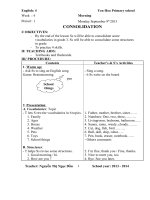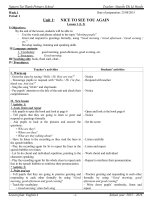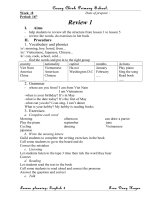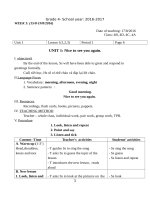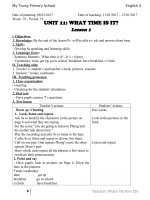Giáo án Tiếng Anh 4
Bạn đang xem bản rút gọn của tài liệu. Xem và tải ngay bản đầy đủ của tài liệu tại đây (132.56 KB, 9 trang )
Date of preparing: 22/ 02/ 2018
Week 23
Period 87
UNIT 13: WOULD YOU LIKE SOME MILK?
Lesson 3: 1-2-3
I. Objectives:
1. Knowledge:
By the end of this lesson, Ps will be able to Use the words and phrases related to the
topic food and drinks, pronounce the sounds of the letters f and sh in the words beef,
leaf and fish, dish respctively.
- Sentence patterns: revision
- Vocabulary: revision
2. Skills: Listening-reading-speaking-writing.
3. Attitude: Educate Sts to love their lesson.
Work hard
III. TEACHING AIDS:
1. Teacher’s: student’s and teacher’s book, pictures, cassette.
2. Students’: books, notebooks, workbooks.
II. TEACHING METHODS:
- Work in pairs , individual, in groups ….
IV. PROCEDURE:
1. Class organization:
- Greeting: Good morning/ Good afternoon. How are you?
- Checking for the students’ attendence:
Class
Date of teaching
Absent Students
4C
27/2/2018
2. Warm up :6’
- Spend a few minutes revising the previous lesson by calling two pairs of pupils to the
board to play the game food or drink?
3. New lesson
Teacher’s and students’ activities
Content
* Activity 1: (8’)
1. Listen and repeat
- Tell Ps that they are going to practise saying the
sounds of the lettes f and sh in the words beef, leaf
and fish, dish respectively.
- First, put the letters f and sh on the board. Play the
recording and ask Ps to repeat a few time. Then write
the word beef, leaf and fish, dish and the four
sentences on the board, play the recording and ask Ps
to repeat a few more times. Play the recording a few
more times and let Ps say the sentences , paying
attention to the target sounds.
- Do choral and individual repetition of the sounds,
words and sentences until Ps feel confident.
- Get some Ps to perform in front of the class. Check
as a class and correct the pronunciation, if necessary.
* Activity 2: (9’)
2. Listen and write. Then
- Tell Ps that they are going to listen to the recording say aloud
and tick the correct answers.
Key: 1 a 2 b 3 a 4 b
- Give the class a few seconds to read the sentences in
silence and guess the words to fill in the gaps.
- Have ps listen to the recording more than one, if
necessary, and tick the appropriate words to fill the
gaps.
- Have them swap their answers before checking as a
class. Then ask ps to read the sentences aloud. Go
aroud and offer help, if necessary.
Key: 1 a 2 b 3 a 4 b
* Activity 3 (6’)
3. Let’s chant
- Tell Ps that they are going to say the chant Would
you like some fish? Follow the procedure in Teaching
the unit components in Introduction.
- Have them read the chant and check comprehension.
- Play the recording more than once, if necessary, for
Ps to do choral and individual repetition until they get
familiarized with the pronunciation, the stress, the
rhythm and the intonation of the chant. Show Ps how
to chant and do actions.
- Divide the class into groups of four and call two
groups to give a demonstration: one group chants the
questions , the other chants the anwers.
- Get groups to sit opposite of each other and practise
chanting and doing acting. Go around offering help, if
necessary.
- Call two pairs to front of the class to chant and do
actions. The rest of the class claps along to the rhythm
4. Consolidation: (3’)
What’s the content of the lesson? Or What have you learnt today?
5. Homelink: (3’)
Do exercises in the workbook. Review the lesson.
6. Comments:
……………………………………………………………………………………………
……………………………………………………………………………………………
……………………………………………………………………………………………
Period 88
UNIT 13: WOULD YOU LIKE SOME MILK?
Lesson 3: 4-5-6
I. Objectives:
1. Knowledge: By the end of this lesson, Ps will be able to read information about food
and drinks.
- Sentence patterns: revision
- Vocabulary: revision,
2. Skills:
- Develop Ss Listening-reading-speaking-writing.
3. Attitude: Educate Sts to love their lesson.
Work hard
III. TEACHING AIDS:
1. Teacher’s: student’s and teacher’s book, pictures, cassette.
2. Students’: books, notebooks, workbooks.
II. TEACHING METHODS:
- Work in pairs , individual, in groups ….
IV. PROCEDURE:
1. Class organization:
- Greeting: Good morning/ Good afternoon. How are you?
- Checking for the students’ attendence:
Class
Date of teaching
Absent Students
4C
27/2/2018
2. Warm up :6’
- Spend a few minutes revising the previous lesson. Get two pairs of ps to go to the front
of the class to say the chant Would you like some fish? And do actions. The rest of class
claps to the rhythm.
3. New lesson
Teacher’s and students’ activities
* Activity 1: (11’)
a. Pre- reading.
- Ask Ps to look at the text and pictures , ask some
questions
Who’s this? What’s this? How many columns are
there?...
- Tell Ps that they are going to read the text and
complete the table.
- Get them to read the text to find the information to fill
Content
4. Read and complete
Key:
Favourite food
Favourite
drink
beef
orange
juice
chicken
lemonade
the blanks. Tell them to focus on Linda’s and Peter’s
favourite food and drink. If necessary, get ps to work in
pairs or small groups.Check understanding.
b. While-reading.
- Give ps time to do the task independently.
- Ps to swap their answers before checking as a class.
Key: Favourite food
Favourite drink
beef
orange juice
chicken
lemonade
c. Post- reading.
- Play the game: Whisper
* Activity 2: (10’)
5. Write about your
a. Pre- writing
favourite food and drink.
- Ask Ps to answer T’s questions.
Key: pupils’ own answer
What’s this? What are we going to do this task?
- Tell ps that they are going to write about favourite
food and drink.
- Have them work in pairs or groups to discuss what
they are going to write in the blanks.
b. While-writing.
- Give ps time to do the task independently.
- Get them to swap their answers before checking as a
class.
- If there is time, ask one ps to write the paragrap on the
board.
Key: pupils’ own answer
c. Post writing.
- Call some Ps to read aloud / display their writing.
* Activity 3: 5’
6. Project
- Tell Ps that they are going to interview their
classmates about their favourite food and drink and
then report the results to the class.
- Give them time to interview three of their classmates
and fill the gaps in the table. Ask them to look at the
first row in the table as an example.
- Ask a few of them to report the results of their
interviews to the class..
4. Consolidation: (3’)
What’s the content of the lesson? Or What have you learnt today?
5. Homelink: (3’)
Do exercises in the workbook.
6. Comments:
……………………………………………………………………………………………
……………………………………………………………………………………………
……………………………………………………………………………………………
Period 89
UNIT 14: WHAT DOES HE LOOK LIKE?
Lesson 1: 1-2
I. Objectives:
1. Knowledge: By the end of this lesson, Ps will be able to use the words and phrases
related to the topic Physical appearance. Ask and answer questions about someone’s
physical appearance, using What does he/she look like?? He’s/ She’s …………..
Sentence patterns: What does he/she look like? He’s/ She’s …………..
Vocabulary: tall, short, slim, old, young
2. Skills:
- Develop Ss reading, writing and listening skills
3. Attitude: Educate Sts to love their lesson.
Work hard
III. TEACHING AIDS:
1. Teacher’s: student’s and teacher’s book, pictures, cassette.
2. Students’: books, notebooks, workbooks.
II. TEACHING METHODS:
- Work in pairs , individual, in groups ….
IV. PROCEDURE:
1. Class organization:
- Greeting: Good morning/ Good afternoon. How are you?
- Checking for the students’ attendence:
Class
Date of teaching
Absent Students
4C
28/2/2018
2. Warm up :6’
Ask pupils to bring a photo of their father/ mother and talk about him/her ( eg: His/ herr
name, age, job and hobby)
3. New lesson
Teacher’s and students’ activities
Content
* Activity 1: (11’)
1.Look, Listen and repeat.
- They are going to read a story in which Phong asks
Linda questions about her brother.
- Ask pupils to look at the four pictures to identify the
characters (Linder and Phong)and the context in which
the language is used.
- Ask them question such as Where are they?What are
they doing?(In picture a, Linda is sitting at the
computer and writing an email to her brother and
Phong is standing nearby. In picture b, c and d, Phong
is asking Linda about her brother the place he lives,
his job and his appearance). Explain the meaning of
the question What does he look like? And the answer
He’s tall. Check comprehension.
- Play the recording more than once, ask students listen
and repeat. Do choral and individual repetition,
pointing to the characters speaking.
- Play the recording again and aks pupils listen and
repeat.
* Activity 2: (10’)
2. Point and say
a. Vocabulary:
a. Vocabulary:
- Ask pupils to look at the pictures and teach the
prases : tall, short, slim, old, young.
+ Checking: Slap the board.
- T guides Ss how to play
b. Model sentences:
A:What does she look like?
B: She’s tall.
- Concept check: intonation, using
c. Practice:
- We are going to practise asking and answering
questions about someone’s physical appearance.
- Ask pupils to look at the bubbles to understand how
to use the language. Ask them to look at the five
pictures to identify the physical appearance of the
people. Elicit the meaning of the adjectives describing
people’s appearance: tall, short, slim, old, young.
- Point to the first picture and ask one pupil to ask what
does she look like? and another to answer She’s tall.
- Ask pupils to do choral and individual repetition.
Repeat the same procedure with the rest of the pictures.
- Ask pupils to work in pairs, pointing to the characters
speaking and to role-play the dialogue.
d.Production:
Activity 3: 6’
- They are going to ask and answer questions about the
appearance of their classmates’ family members, using
What does your father/ mother/ brother/ sister look
farmer, nurse, driver and
factory worker.
b. Model sentences:
A:What does your father
do?
B: He’s a farmer.
* Work in pairs. Ask and
answer questions about the
appearance
of
their
classmates’ family members
like? And He’s /She’s…..
- Ask them to work in pairs.
- Select some pairs to role play the dialogue in front of
the class.
4. Consolidation: (3’)
What’s the content of the lesson? Or What have you learnt today?
5. Homelink: (3’)
Do exercises in the workbook. Learn by heart the new words.
6. Comments:
……………………………………………………………………………………………
……………………………………………………………………………………………
……………………………………………………………………………………………
Period 90
UNIT 14: WHAT DOES HE LOOK LIKE?
Lesson 1: 3-4-5
I. Objectives:
1. Knowledge: By the end of this lesson, Ps will be able to listen to specific information
and write about someone’s physical appearance, using What does he/she look like??
He’s/ She’s …………..
- Sentence patterns: revision
- Vocabulary: revision
2. Skills:
- Develop Ss Listening-reading-speaking-writing.
3. Attitude: Educate Sts to love their lesson.
Work hard
III. TEACHING AIDS:
1. Teacher’s: student’s and teacher’s book, pictures, cassette.
2. Students’: books, notebooks, workbooks.
II. TEACHING METHODS:
- Work in pairs , individual, in groups ….
IV. PROCEDURE:
1. Class organization:
- Greeting: Good morning/ Good afternoon. How are you?
- Checking for the students’ attendence:
Class
Date of teaching
Absent Students
4C
28/2/2018
2. Warm up :6’
Spend a few minutes revising the question What does he/she look like? And the answer
He’s / She’s .. Get pairs to role- play the question and the answer.
3. New lesson
Teacher’s and students’ activities
* Activity 1: (11’)
a. Pre-listening:
- T looks at the books and sets the scence:
How many numbers are there?What does she/ he
look like?
- We are going to listen to three dialogues about
people’s appearance and tick the correct picture.
- Ask pupils to look at the pictures to identify the
appearance of the people. Ask them question such as
(Is she tall or short? Is he big or small?.). Check
understanding.
b. While-listening:
- Play the recording few times. Ask pupils listen and
tick the correct the picture.
- Ask pupils to swap their answers .
Key: 1c
2c 3a
c. Post listening:
- Play the game: Lucky number
* Activity 2: (11’)
a. Pre- writing:
How many pictures are they? What does he/ she look
like?
- We are going to complete the answers about
someone’s appearance, using the picture cues.
- Ask pupils to look at the picture and the answer
in 1.
- Ask pupils to look at the other picture and use the
appropriate words to complete the answers.
b. While- writing:
- Ask pupils to work in pairs.
- Ask pupils to do the tast independently.
- Ask pupils to swap their answers.
- If there is inough time, invite some pairs to act out
the dialogues.
Key: 1. He’s tall/ slim .
2. She’s short/ young.
3. They’re old .
4. They’re young/ tall.
c. Post writing:
- Have Ps play a game : Telephone game
* Activity 3: (5’)
- We are going to play the game Find someone who…,
using the words related to people’s physical
Content
3. Listen and tick:
Key: 1c
2c 3a
4. Look and write:
Key: 1. He’s tall/ slim .
2. She’s short/ young.
3. They’re old .
4. They’re young/ tall.
5. Let’s play
appearance.
- Divide the class into groups of five. Say to ps Find
someone who….. (eg: find someone who’s tall) The
group which is the quickest to point to a classmate
who fits that description and says the correct sentence(
eg: Tu is tall) gets a point. The group that gets most
points wins.
4. Consolidation: (3’)
What’s the content of the lesson? Or What have you learnt today?
5. Homelink: (3’)
Do exercises in the workbook. Review the lesson and prepare next lesson.
6. Comments:
……………………………………………………………………………………………
……………………………………………………………………………………………
……………………………………………………………………………………………

